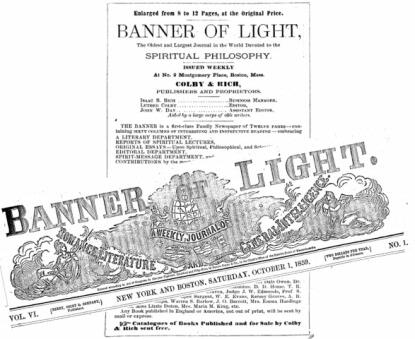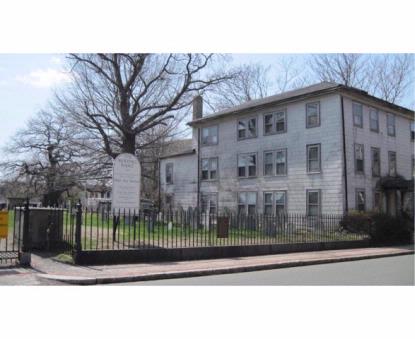The religious movement known as “Spiritualism” permeated nineteenth-century life, growing so rapidly that, by 1869, Emma Hardinge [Britten](1823–1899), historian of the first two decades of the religion, estimated that there were eleven million Spiritualists “on the American continent” alone. Estimates made by various publications concluded that perhaps nearly half the population believed in some aspect of Spiritualism, which, briefly, is the belief that the spirits of the dead can communicate with the living.
Boston, a hotspot for Spiritualism, boasted what was one of the most important and widely circulated periodicals. The Banner of Light, founded in 1857, had a national audience. It published weekly lists of Spiritualist lectures and meetings, along with literary works, chitchat, editorials, and listings of mediums and lecturers.

A central feature of the paper was the publishing of communiqués from the spirit world gathered from séances held in the newspaper’s offices by famed medium Frances Ann Crowell (Mrs. J.H.) Conant (1831–1875).

Nathaniel Hawthorne, whose authorial talents were nurtured by and imbued with the stories and shadows of Salem’s past, married into the metaphysical. His wife, Sophia Amelia Peabody Hawthorne (1809–1871), remained deeply interested in Spiritualism and related subjects all of her life, and her sister Elizabeth (Lizzie) became an enthusiastic Spiritualist.
Although the Hawthornes had their scattered experiences with Spiritualism throughout their lives, during the family’s 1858 sojourn in Italy they would have numerous encounters with the spirit lands.
The Hawthornes associated with a small group of expatriate American (and English) artists living in Rome and in Florence. Spiritualism was strong among members of the group. Many of their adventures with Spiritualism began when poets Robert and Elizabeth (Barrett) Browning invited them to call.
June 9th.—We went last evening, at eight o’clock, to see the Brownings….
We had some tea and some strawberries, and passed a pleasant evening. There was no very noteworthy conversation; the most interesting topic being that disagreeable and now wearisome one of spiritual communications…Mrs. Browning is a believer, and her husband an infidel.
There was much more to come for the Hawthornes than conversation, however.
Last Saturday, August 28th, we went to take tea at Miss Blagden’s, who has a weekly reception on that evening…. Miss — has lately been exercising her faculties as a spiritual writing-medium….
The “Miss —” was Ada Shepard, the Hawthorne children’s governess, who discovered hitherto unsuspected mediumistic powers during a séance at the Villa Brichieri, where Isa Blagden (1816–1873) held her weekly literary receptions.
Hawthorne struggled with his unsettled ambivalence toward séances, mediums and the entire cosmology of the movement. Now, Spiritualism was no longer just a topic of conversation but was also very much in their lives.
We have had written communications through Miss — with several spirits; my wife’s father, mother, two brothers, and a sister, who died long ago, in infancy; a certain Mary Hall, who announces herself as the guardian spirit of Miss; and, queerest of all, a Mary Runnel, who seems to be a wandering spirit, having relations with nobody, but thrusts her finger into everybody’s affairs. My wife’s mother is the principal communicant….
Hawthorne watched as Sophia became more immersed in the communication with her beloved mother, she finding it all “curious and wonderful.” Her husband mused that it was all, somehow, a manifestation of psychology:
The whole matter seems to me a sort of dreaming awake. It resembles a dream…. Mary Runnel is the only personage who does not come evidently from dream-land….
Hawthorne privately mused, “I should be glad to believe in the genuineness of these spirits, if I could”; but, perhaps somewhat to his own regret, he continued ambivalent to the end.
****
It is perhaps, of interest, that after Nathaniel Hawthorne’s death, his son Julian came into possession of “three folio volumes,” the existence of which he had never before known. In his examination of the contents, he found a story of doomed romance: an “amatory correspondence between one of my own ancestors and a young lady bearing the unusual name of Mary Rondel.”
Julian wrote to some of his Ingersoll kin, asking what they might know about the name.
They replied that, though the story was largely unknown, family tradition had passed down the story of a young Boston woman, who, in about the year 1750, had been perhaps betrothed to their ancestor Daniel Hathorne; he, however, married another. Apparently the break was abrupt, and Miss Rondel died shortly thereafter.
And that, said the sisters Ingersoll, was all they knew.
Julian wrote, “And she had ever since that time been wandering to and fro ill at ease, until this opportunity came to declare herself, and to claim the sympathy of Daniel’s remote descendant. It is one of the most convincing spiritualistic stories I ever heard.”
This article is excerpted from:
A History of Spiritualism and the Occult in Salem: The Rise of Witch City
by Maggi Smith-Dalton (Charleston, SC: History Press, 2012)
All images were previously printed in A History of Spiritualism …. Captions and credits, top-to bottom:
The Banner of Light, Boston newspaper with National Clout; Collection of the Author
The house where Nat Met Sophie…The Grimshawe House, Salem, Massachusetts; Photo by Maggi Smith-Dalton


